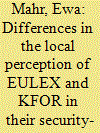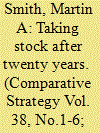| Srl | Item |
| 1 |
ID:
178613


|
|
|
|
|
| Summary/Abstract |
This article compares the local perceptions of the EU Rule of Law Mission in Kosovo (EULEX) with those of NATO’s mission Kosovo Force (KFOR) and investigates the reasons for observed differences. It focuses on an oft-overlooked aspect of EULEX: its broadly defined security-related tasks. Until recently, EULEX could be seen as a prominent security actor, thanks to its robust police component and its function as a second respondent. EULEX coexists in Kosovo with KFOR; while the former is civilian and the latter military, both play complementary roles in the security realm and some of their tasks are similar. However, the local perceptions of EULEX and KFOR regarding their execution of security-related tasks have differed, with only KFOR enjoying local acceptance. This article argues that such differences are caused by the missions’ differently perceived powers over local actors, as manifested through their ability to exert compliance and cooperation from local actors through coercion, the ability to offer rewards and legitimacy. By going beyond the well-researched initial gratitude of Kosovo Albanians to NATO/US for intervening in 1999, this article offers a more fine-grained analysis of Kosovo Albanian and Kosovo Serbian perceptions of EULEX and KFOR.
|
|
|
|
|
|
|
|
|
|
|
|
|
|
|
|
| 2 |
ID:
170466


|
|
|
|
|
| Summary/Abstract |
Overall, there is mixed evidence of the enduring impact of the Kosovo crisis and Operation Allied Force (OAF) twenty years after the events. OAF and the follow-on deployment of the Kosovo Force (KFOR) in 1999 did consolidate and in effect make permanent a NATO and wider Western presence and set of interests in the Balkan region. NATO’s use of force against Serbia also caused the most serious rupture to date in its already-fragile institutional and diplomatic relationship with Russia, which revealed its fundamental weaknesses and limitations and from which it would never fully recover. On the other hand, and despite the widely perceived existential importance of its prevailing over Kosovo for NATO’s institutional credibility and effectiveness at the time, the longer-term impact of OAF and the KFOR deployment has proved transient and limited in terms of the institution’s ongoing post–Cold War evolution. This is evident not least in the failure to sustain and develop any distinct humanitarian dimension to NATO over the past two decades.
|
|
|
|
|
|
|
|
|
|
|
|
|
|
|
|
| 3 |
ID:
145022


|
|
|
|
|
| Summary/Abstract |
It is commonly accepted that peace operations produce public goods. Informed by theories of collective action, the article tests the claim that middle powers were free-riders in NATO’s peace operations in the Balkans (IFOR, SFOR, KFOR) from 1995–2001. In so doing, we charge that calculating the level of defence spending as a share of a country’s GDP, which has become the standard index in the literature, is limiting. We suggest that the active military-duty force share index is a better index to use, and find that middle powers did not free-ride in NATO’s peace operations in the 1990s. Quite to the contrary: they contributed more to NATO’s public good of peacekeeping than countries like France or Germany, and more than expected based on their economic abilities measured in GDP. The article then asks what could be inferred from this analysis, and offers theoretical and methodological points of critique before suggesting new avenues for future research in this vibrant research programme.
|
|
|
|
|
|
|
|
|
|
|
|
|
|
|
|